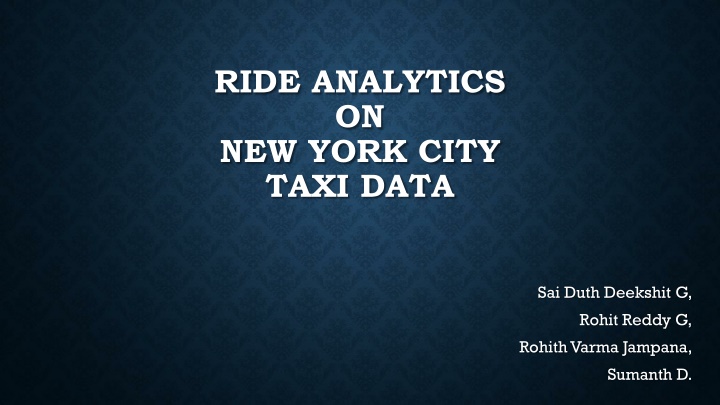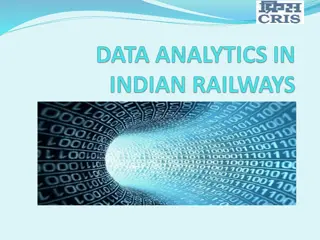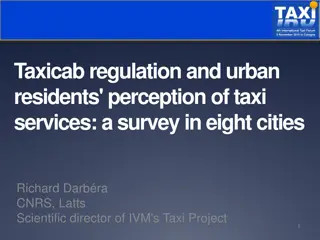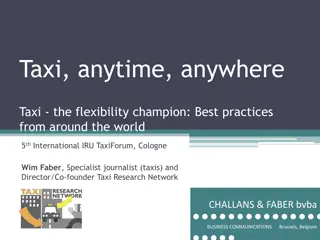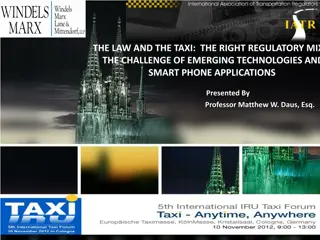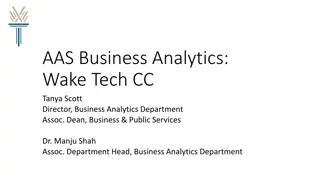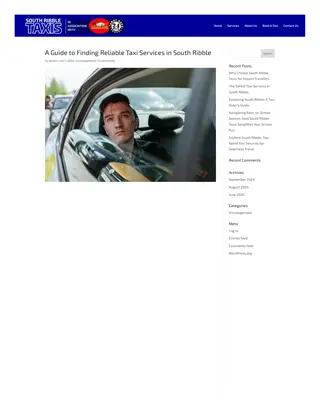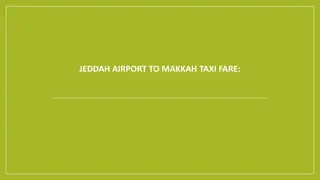Ride Analytics on NYC Taxi Data
Transportation is crucial in large cities, and NYC taxis play a vital role. This project analyzes ride data to identify common locations, busiest routes, revenue-generating areas, and driver adherence to routes. Using techniques like Continuous Nearest Neighbor Search and Apache Spark, insightful analytics are performed. APIs like Yelp and Google Matrix Distance aid in data processing. Explore the future applications and references for enhancing business and government strategies.
Download Presentation

Please find below an Image/Link to download the presentation.
The content on the website is provided AS IS for your information and personal use only. It may not be sold, licensed, or shared on other websites without obtaining consent from the author.If you encounter any issues during the download, it is possible that the publisher has removed the file from their server.
You are allowed to download the files provided on this website for personal or commercial use, subject to the condition that they are used lawfully. All files are the property of their respective owners.
The content on the website is provided AS IS for your information and personal use only. It may not be sold, licensed, or shared on other websites without obtaining consent from the author.
E N D
Presentation Transcript
RIDE ANALYTICS ON NEW YORK CITY TAXI DATA Sai Duth Deekshit G, Rohit Reddy G, RohithVarma Jampana, Sumanth D.
CONTENTS Introduction Project Description Back Ground Problem definition and Solutions Techniques used Future Work References
INTRODUCTION Transportation plays a vital role in large cities Taxi mode of transportation has become a key player in large cities of united states and other countries. In NYC approximately 50,000 vehicles and 1,00,000 drivers exist. Different variety of service providers are Uber, Yellow Taxi, Green Taxi etc. The data that contain ride details was made available by NYC taxi and Limousine commission. We use these details to perform analytics on ride data that would benefit businesses of various types and government.
PROJECT DESCRIPTION In this project we perform analytics on NYC taxi data and find solutions to queries like : Most common pick up and drop-off locations Busiest routes for taxis Most revenue generated areas for cabs Popularity of the places Know whether driver took the correct route or not Find popular places between pick up and drop off locations
BACKGROUND WORK Yufei Tao, Dimitris Papadias, Qiongmao Shen. Continuous Nearest Neighbor Search . Proceedings of the 28thVLDB conference, Hong Kong, China, 2002. Apache Spark: An engine for processing big data in fast and efficient manner Contain several built in modules for streaming, SQL, machine learning and graph processing Provide an API known as Resilient Distributed Dataset (RDD) RDD allows to develop both iterative algorithms which require dataset to visit several times in a loop and exploratory data analysis(repeated database style querying of data) Process and execute batch jobs much better and faster than MapReduce. It run on Hadoop along with other tools like Hive Pig which come under Hadoop ecosystem
CONT Yelp API which provide us the business name and address around the given location(latitude and longitude) Google Matrix Distance API provide us road network distance between two locations by taking coordinated of two locations as input
SOFTWARE & HARDWARE REQUIREMENTS Query Languages: DBMS, SQL Programming Languages: Scala, Python, Java Online tools: www.databricks.com (For running Scala or Python cells and storing the data) API s : YELP API, Google Distance Matrix API Windows or MAC OS, RAM:4GB or more, HDD: Minimum 50GB, Internet connection
PROBLEM DEFINITION The problem is defined in three stages: 1stStage: Data cleaning and Analysis on Ride data 2ndStage: Finding popular places between pick up and drop off location 3rdStage: Visualization of results
CLEANING AND ANALYSIS ON RIDE DATA Data Set Link: http://www.nyc.gov/html/tlc/html/about/trip_record_data.shtml The initial data set contain unnecessary fields which are of no use in the analysis like VendorId, RateCodeID, Store_and_fwd_flag, Tolls_amount, Improvement Also, remove invalid data (check for blank entries and delete them) The final data set that was cleaned contains the following fields which will be used for our analysis: Pickup_datatime, dropoff_datetime, passenger_count, trip_distance, pickup_longitude, pickup_latitude, dropoff_longitude, dropoff_latitude, payment_type, fare_amount, trip_amount
CONTN Now we perform Analysis on ride data to find: Most common pick up and drop-off locations Busiest routes for taxis Most revenue generated areas for cabs Popularity of the places Know whether driver took the correct route or not Find popular places between pick up and drop off locations
TECHNIQUES USED For finding the famous places between two points we use: Continuous Nearest Neighborhood integrated with Google Distance Matrix API Google Distance Matrix API : https://maps.googleapis.com/maps/api/distancematrix/outputFormat?parameters OutputFormat can be either JSON or XML format Parameters can be origins = latitude, longitude | latitude, longitude For querying multiple points we can use Polyline Algorithm format
FINDING CONTINUOUS NEAREST NEIGHBOR (CNN) It retrieves the nearest neighbor of every point on a line segment Splint point is the point on the line segment where there is a change of neighborhood Use R-tree as datastructure, take MBR of intermediate node Given E and q (line segment), subtree of E contains qualifying points only If mindist (E, q) < SLmaxd else it is not qualified If dist(Si, Si NN) > mindist (Si, E) It is clear that for entries that are closer to line segment there is high possibility to qualify Entries that satisfy the above condition are accessed in increasing order of their minimum distances (distance is found using Google Distance Matrix API) we get the set of split nodes Scover = {split points} and their nearest neighbors Finally, as a result we get a set of <Point, Interval> Ex: <a, {s1,s2}>
ALGORITHM FOR FINDING POPULAR PLACES BETWEEN TWO POINTS: Select source and destination location coordinates which will be the pick-up and drop-off coordinates Call findNeighbors ( ) method which will return a set of <Point, interval>. Where, Point is the nearest neighbor and interval is the interval for which Point is nearest neighbor Store the result obtained above and use findPopularity ( ) method to find the popularity of the above obtained result Display top 5 results based on the popularity
FUTURE WORK The result of analysis can be used to help taxi drivers to decide in which area they need to go so they get maximum customers and boost their business New taxi business can also gain from the analysis Traffic analysis: Finds which routes and times of the day are heavy on traffic Provide visualization like heated maps and route visualization Decrease traffic congestion and reduce CO2 emissions by start using public transport instead of individual transport Find potential for pool/sharing taxi business
REFERENCES NYC Taxi & Limousine Commission. http://www.nyc.gov/html/tlc/html/about/about.shtml Yufei Tao, Dimitris Papadias, Qiongmao Shen. Continuous Nearest Neighbor Search . Proceedings of the 28th VLDB conference, Hong Kong, China, 2002.
THANK YOU QUERIES????
